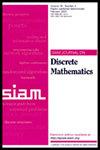超临界无标度网络上的议论性选民模型
IF 0.9
3区 数学
Q2 MATHEMATICS
引用次数: 0
摘要
SIAM 离散数学杂志》第 38 卷第 2 期第 1285-1314 页,2024 年 6 月。 摘要投票者模型是一个经典的相互作用粒子系统,它模拟了全球共识是如何通过局部模仿形成的。我们分析了当底层结构是一个无标度的非均质随机图时,在高边沿密度系统中,一个特定的投票者模型族达成共识的时间。在这种情况下,我们验证了共识的多项式阶数与平均场近似 [A. Moinet, A. Barrat] 中的多项式阶数一致。Moinet, A. Barrat, and R. Pastor-Satorras, Phys. Rev. E, 98 (2018), 022303]。这个 "辨证 "模型系列有一个对称的相互作用,以更好地模拟讨论,并以一个温度参数为指标,对于网络度分布幂律尾的某些参数,可以看到共识速度会产生两个不同的阶段。我们的证明依赖于众所周知的凝聚随机游走的对偶性,以及利用已知的厄尔多斯-雷尼巨型子图的快速混合对这些游走的混合时间的新约束。与亚临界情况不同 [J. Fernley 和 M. Ort.Fernley 和 M. Ortgiese,Random Structures Algorithms,62 (2023),pp. 376-429]需要极限度分布的尾指数[数学]以及低边缘密度,而在巨型分量情况下,我们还解决了 "超小世界 "幂律指数[数学]。本文章由计算机程序翻译,如有差异,请以英文原文为准。
Discursive Voter Models on the Supercritical Scale-Free Network
SIAM Journal on Discrete Mathematics, Volume 38, Issue 2, Page 1285-1314, June 2024.
Abstract. The voter model is a classical interacting particle system, modeling how global consensus is formed by local imitation. We analyze the time to consensus for a particular family of voter models when the underlying structure is a scale-free inhomogeneous random graph in the high edge–density regime, where this graph features a giant component. In this regime, we verify that the polynomial orders of consensus agree with those of their mean-field approximation in [A. Moinet, A. Barrat, and R. Pastor-Satorras, Phys. Rev. E, 98 (2018), 022303]. This “discursive” family of models has a symmetrized interaction to better model discussions and is indexed by a temperature parameter that, for certain parameters of the power law tail of the network’s degree distribution, is seen to produce two distinct phases of consensus speed. Our proofs rely on the well-known duality to coalescing random walks and a novel bound on the mixing time of these walks using the known fast mixing of the Erdős–Rényi giant subgraph. Unlike in the subcritical case [J. Fernley and M. Ortgiese, Random Structures Algorithms, 62 (2023), pp. 376–429], which requires tail exponent of the limiting degree distribution [math] as well as low edge density, in the giant component case, we also address the “ultrasmall world” power law exponents [math].
Abstract. The voter model is a classical interacting particle system, modeling how global consensus is formed by local imitation. We analyze the time to consensus for a particular family of voter models when the underlying structure is a scale-free inhomogeneous random graph in the high edge–density regime, where this graph features a giant component. In this regime, we verify that the polynomial orders of consensus agree with those of their mean-field approximation in [A. Moinet, A. Barrat, and R. Pastor-Satorras, Phys. Rev. E, 98 (2018), 022303]. This “discursive” family of models has a symmetrized interaction to better model discussions and is indexed by a temperature parameter that, for certain parameters of the power law tail of the network’s degree distribution, is seen to produce two distinct phases of consensus speed. Our proofs rely on the well-known duality to coalescing random walks and a novel bound on the mixing time of these walks using the known fast mixing of the Erdős–Rényi giant subgraph. Unlike in the subcritical case [J. Fernley and M. Ortgiese, Random Structures Algorithms, 62 (2023), pp. 376–429], which requires tail exponent of the limiting degree distribution [math] as well as low edge density, in the giant component case, we also address the “ultrasmall world” power law exponents [math].
求助全文
通过发布文献求助,成功后即可免费获取论文全文。
去求助
来源期刊
CiteScore
1.90
自引率
0.00%
发文量
124
审稿时长
4-8 weeks
期刊介绍:
SIAM Journal on Discrete Mathematics (SIDMA) publishes research papers of exceptional quality in pure and applied discrete mathematics, broadly interpreted. The journal''s focus is primarily theoretical rather than empirical, but the editors welcome papers that evolve from or have potential application to real-world problems. Submissions must be clearly written and make a significant contribution.
Topics include but are not limited to:
properties of and extremal problems for discrete structures
combinatorial optimization, including approximation algorithms
algebraic and enumerative combinatorics
coding and information theory
additive, analytic combinatorics and number theory
combinatorial matrix theory and spectral graph theory
design and analysis of algorithms for discrete structures
discrete problems in computational complexity
discrete and computational geometry
discrete methods in computational biology, and bioinformatics
probabilistic methods and randomized algorithms.

 求助内容:
求助内容: 应助结果提醒方式:
应助结果提醒方式:


